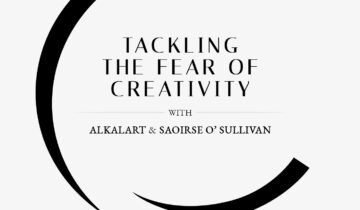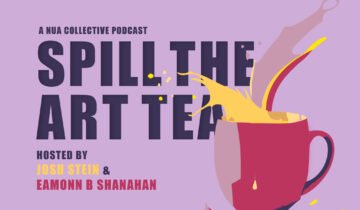By Anne Martin Walsh – Click here to discover Anne’s work here.
Looking at the art happening in America up to the 1970’s, it was controlled by concepts taken from the experiential, philosophical and a psychoanalytic perfectionism, and looks at concepts of the postmodern decades. According to the critic, Rosalind Krauss, the advent of Postmodernism was a reaction to the growing categories of Modernism which gave the artist a much expanded field to examine and work with, due to not being restricted by medium. However, Craig Owens, author of The discourse of Others: Feminist and Postmodernism, 1985, argues that it was the aesthetic of language, the writing of many critics/artists, that marked out the origin of Postmodernism. These critics, like Lucy R. Lippard and Griselda Pollock, gave way to a stream of literary theory. They, along with others such as Dorothy E. Smith, were inclined towards a Marxist politics and felt empathy for the minority categories.
Feminisms idea that the personal was political had an extensive effect on how things were seen, giving so many new directions to the idea of politics. The Indigenous American Jaune Quick-to-See Smith was a part of this when, having joined ‘The Women’s Movement’, she incorporated the items of women’s daily lives into work. Some females turned to the pre- historic matriarchy and goddess culture, saying that Mother Earth was the creator of all living things, others argued that associating women with nature actually weakened their feminist cause. The 3rd Wave Feminists of today work to help end the violence and hatred directed at women all over the world, while continuing the battle for equality. An Indigenous American point of view is stressed by Dean Rader, as he tells us that these indigenous American Indians used artistic expression as a way of articulating cultural hegemony, autonomy and survival. Lucy R. Lippard discusses in her book, UNDERMINING, A Wild Ride Through Land Use, Politics, and Art in the Changing West. The New Press, New York. 2014, how Indian reservation land, historically located in places considered useless, and in a blatant act of discrimination, was illegally appropriated when the mineral rich earth was discovered.

The artist Jaune Quick-to-See Smith, her inspiration and the ideology behind her practice. She graduated from a Masters in Fine Art from the University of New Mexico in 1980. In our present day, Jaune Quick-to-See Smith is hugely acclaimed as an Indigenous American Artist, having received many awards for her artistic endeavours, with work in collections worldwide. Smith’s motivation comes from her life experiences, which are quite complex, and this complexity can be seen in the visual messages created throughout her artwork. Her spiritual belief, like all indigenous Americans, in a binding connection to the earth, along with her Native American nurturing and the effect of a contemporary art education, results in her work being a form of intercultural, abstract expressionism. ‘The intentionality of place’, it’s importance to the American Indian, and its strong presence and significance in the work of Jaune Quick-to-See Smith. The critic Lucy R. Lippard wrote that in the context of American art, opinions on the complexity and contentious relationship the indigenous people had with their land, their sense of place, transcended the dominant culture’s destructive, selfish and insignificant ideology towards the earth.
Adele Getty, in A. Goddess, Mother of Living Nature, published by Thames and Hudson Ltd. London, 1990, writes of how the European settles, on reaching the Americas, proceeded to destroy the great forests, wipe out the buffalo herds and all but exterminate the indigenous people through thoughtlessness and greed. The constant struggles of the indigenous people of America is the motivation and inspiration behind Jaune Quick-to-See Smith’s artwork. Carolyn Kastner, in Jaune Quick-to-See Smith: An American Modernist. Albuquerque: University of New Mexico Press, 2013, is of the opinion that Smith can be placed within a specific historical and cultural context, siting similarities between de Kooning, Kandinsky, and the pop artist John’s, and Jaune Quick-to-See Smith’s work. Smith has always taken her position as artistic political activist earnestly.

Oil Acrylic and mixed media on canvas.
66 x 50 ins
(Selected Paintings. Jaune Quick-to-See Smith. 2018.)
There is a dialogue to be ensued on how there is a wonderful regenerative potential around artworks that raise awareness of land issues, place and cultural history. A lot of how the indigenous people feel, their cognizance, is held within their own circle, conserving spiritual and political hegemony, yet they refuse to be relegated to the history books, determined to be taken seriously in the here and now. The narrative of Jaune Quick-to-See Smith’s work is quite subtle unlike other provocative artists such as Andre Serrano and, even though both artists are protesting against a type of oppression, Jaune Quick-to-See Smith’s work is less obviously antagonistic. Smith’s type of participatory resistance is examined through taking a closer look at some of her ‘map’ paintings as well as the artistic strategy in her use of the colour red. Her ethical visual lexicon can be seen as a strong representation of sovereignty.

Smith’s work is a politically artistic record of the way the American Government has shamelessly treated its native people, told in a way unique to this artist’s practice. Jaune Quick-to-See Smith’s engaged resistance through the medium of her practice is not an antagonistic shock tactic, it is more about her persistence, and the consistency throughout her work, in an endeavour to relate the indigenous narrative. Smith’s lifelong resolution is to make a difference for her people.
By Anne Martin Walsh – Click here to discover Anne’s work here.






 No products in the cart.
No products in the cart.